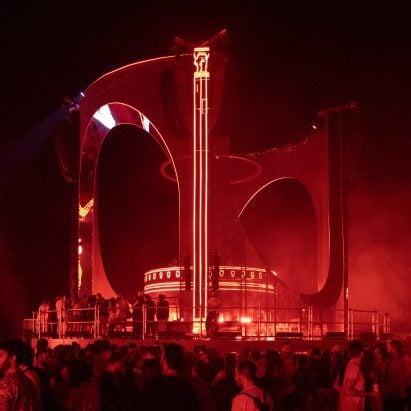Architecture studio Stufish created a futuristic interpretation of a Roman amphitheatre for a stage at an electronic music festival on Italy‘s Adriatic Coast.
The inaugural Adriatic Sound Festival was held on June 13-14 at a private airport outside the historic city of Fano.
Entertainment architecture specialist Stufish was appointed to design the event’s two stages, one to host DJs playing house music and another for techno.
Stufish drew on Roman architecture in its stage designs for Adriatic Sound Festival
“To create a new festival from a blank canvas meant for both us and the producers that we had to invite the audience to a space that feels unique, connected to its site and context, but also contemporary and otherworldly,” Stufish designer Zarya Vrabcheva told Dezeen.
“We wanted to build two worlds for the two stages so that they feel very different, but also each to elevate the dancefloor experience in its own way.”
The main stage, titled The Temple, was conceived as a 360-degree spectacle, with a circular, revolvable DJ podium housed within a sculptural tower at the centre of a temporary amphitheatre.
Seen from the festival entrance, The Temple stage takes the shape of an arch
Revellers entering the festival were greeted by the tower, with its arched form allowing a view through to a vast LED screen at the edge of the arena, also in the shape of an arch.
Viewed from another direction, The Temple stage tower’s silhouette takes the form of an inverted arch in a U-shape, while from another, the shapes morph to resemble the infinity symbol in keeping with the festival’s theme of “beyond time”.
Pillars and a vast LED-screen arch help establish the feeling of being in an amphitheatre
The use of arches is a reference to the Roman architecture of Fano – specifically the Arch of Augustus, a triumphal arch in the city built to honour emperor Augustus.
“More than 2,000 years later, we used this symbol as a portal to another world, a temporary city where people congregated from places all around the world to Fano, united by music,” said Vrabcheva.
The circular DJ booth can rotate 360 degrees
Mirrored surfaces and metal mesh caused the stage structure to shimmer during the daytime, while after dark they amplified the effects of extensive lighting infrastructure.
Lasers that were mounted on pillars encircling the stage criss-crossed over dancers’ heads to form a dome-shaped canopy, or roved across the night sky.
Mesh and mirrors were chosen to enhance the effect of the lights
These pillars, as well as the arch screen, were illuminated to resemble touchstone elements of classical Roman architecture, albeit in neon colours.
Meanwhile, LEDs fitted behind the mesh panels gave the impression of the stage glowing from within, with the layers of permeable material also creating a moiré effect. A halo suspended above the DJ booth added further illumination.
Lasers cast about the night sky or formed a notional roof above the arena
Local air-traffic controllers were advised to keep the airspace above the festival clear because of the extensive use of lights and lasers.
All the audio equipment was housed within the stage – most of it embedded in the base, but other speakers were also suspended from an overhead rig. These were chosen to have the slimmest proportions possible to minimise the visual impact on the stage.
To recreate the atmosphere of a nightclub, some festivalgoers were able to dance on platforms surrounding the DJ podium
The DJ podium was raised to the third storey, with two lower levels functioning as ring-shaped dancefloors open to VIPs in a nightclub-like environment.
Four crescent-shaped grandstands were stationed to form the edges of the arena, to emphasise the impression of being in an amphitheatre. These could be moved inwards or outside to adjust crowd capacity.
References to classical Roman architecture continued at the festival’s second, techno-focused stage, The Hangar.
This more conventional stage was erected in front of three aircraft hangars, with 3D projection mapping used to mock up the buildings with Pantheon-style colonnades.
Colonnades were projected onto aircraft hangars forming the backdrop to the second stage
To minimise the amount of time required to close the airport, the stage needed to be assembled in a matter of days.
In contrast to the nightclub feel of The Temple, the sparser architecture here was also intended to facilitate the atmosphere of a rave, in keeping with the throbbing music on offer.
All materials for the two stages were sourced locally, according to Stufish, with The Hangar made entirely from rental stock to eliminate waste.
While The Temple recalled a nightclub, The Hangar was designed to feel like a rave
Meanwhile, Adriatic Sound Festival’s organisers have purchased The Temple stage with the intention of reusing and adapting it for future editions.
Other structures created for music festivals previously covered on Dezeen include a demountable fibreglass stage by Cake Architecture, another made from repurposed steel beams by Piovenefabi and a series of giant fabric mushrooms at Coachella by Do Lab.
The photography is courtesy of Stufish.
Project credits:
Client: Adriatic Sound Festival; JRL Projects
Executive producers: Luca Lewis; Robert Lewis; Nicolò Baldelli
Production director: Whiteowl Tribe − Marco Marchesi Morselli; Greta Arditi; Francesca Giuntini
Production manager: Produzioni Live − Tony de Grandis; Fabiana Palama; Gloria Battistini
Lighting design: Jacopo Ricci; Vittorio Campagnolo; Domenico Paone
Video design: Francesco Taddeucci; Lorenzo Bosucci
Sound design: Davide Lombardi; Backstage Service
Special effects: SuperFX
Structures, video, light and sound supply and build: Backstage Service
Scenic build: Innscena
The post Stufish builds dance-music colosseum for Adriatic Sound Festival appeared first on Dezeen.
